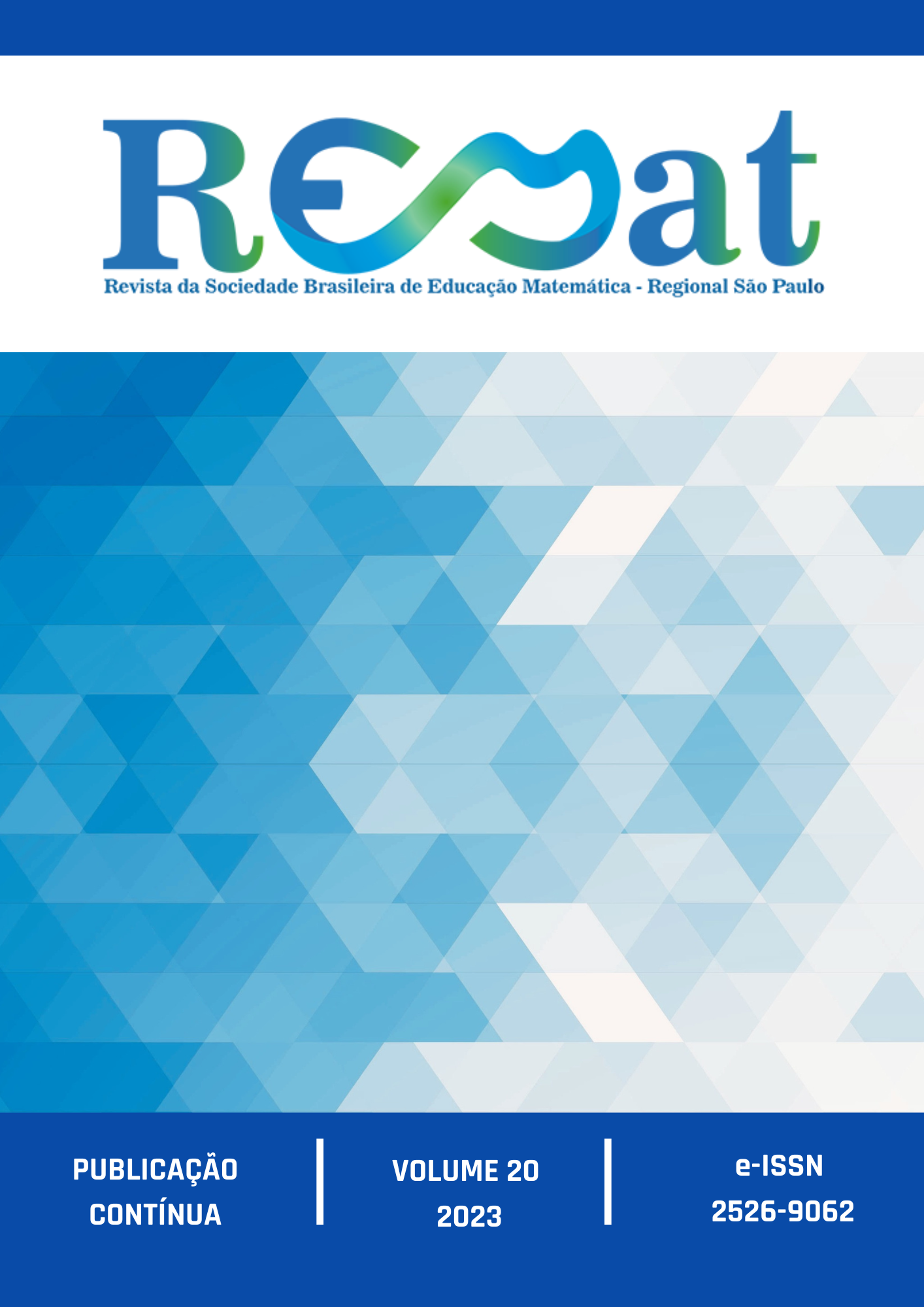Mathematics that feels on the skin: the Mathematical Thinking of deafblind students
DOI:
10.37001/remat25269062v20id763Keywords:
Deafblind students, Mathematical Thinking, Knowledge productionAbstract
This article, with a descriptive qualitative approach, with the characteristics of a multiple case study, aims to present and discuss the results of a doctoral research that aimed to investigate and discuss characteristics of the Mathematical Thinking of deafblind students at a school in the city of LondrinaPR. For that, the Semantic Fields Model (SCM), proposed by Rômulo Campos Lins, was assumed as an epistemological and methodological perspective. As theoretical support, a characterization was adopted for the mode of production of meanings for Mathematics expected from students in the educational context of Paraná, developed from the production of meanings of the first author of this work for the residues of enunciations contained in the Curricular Guidelines for Education of Paraná for the discipline of Mathematics. Having these references, we carried out a reading of the residues of utterances of two students, produced during semi-structured interviews that aimed to characterize the school contexts in which they were and/or are inserted and a characterization for the modes of production of meanings for Mathematics, or even, for the Mathematical Thought of each one of them. The study showed that the most present and valued way in all students' school learning, from concrete to abstract notions, after the emergence of deafblindness, was inseparable from the manipulation, present or past, of physical objects. Only one of the students demonstrated the expected Mathematical Thought in the context in which they are inserted, and that both demonstrate, in their ways of dealing with Mathematics, objectifying mathematical notions and referring to “concrete”, “everyday”objects.
Downloads
Metrics
References
ALMEIDA, W. G. A educação de surdocegos: novos olhares sobre a diferença. In: ALMEIDA, W. G. (Org.). Educação de surdos: formação, estratégias e prática docente. Ilhéus: Editus, 2015. p. 159-190.
______. O guia intérprete e a inclusão da pessoa com surdocegueira. Ilhéus: Editus, 2019.
BOGDAN, R. C.; BIKLEN, S. K. Investigação qualitativa em Educação: uma introdução à teoria e aos métodos. Portugal: Porto Editora, 1994.
GLAT, R.; FERREIRA, J. R. Panorama Nacional da Educação Inclusiva no Brasil. Relatório de consultoria técnica, Banco Mundial, 2003. Disponível em: file:///C:/Users/Marcelo/AppData/Local/Temp/Panorama%20Nacional%20da%20Educa%C3%A7%C3%A3o%20Inclusiva%20no%20Brasil.pdf. Acesso em: 15 set. 2020.
JANUZZI, G. M. A educação do deficiente no Brasil: dos primórdios ao início do século XXI. 1. ed. Campinas: Autores Associados, 2004.
KASSAR, M. C. M. Educação especial na perspectiva da educação inclusiva: desafios da implantação de uma política nacional. Educar em Revista, Curitiba, n. 41, p. 61-79, set. 2011.
LINS, R.C. Epistemologia, História e Educação Matemática: Tornando mais Sólidas as Bases da Pesquisa. Revista de Educação Matemática da SBEM-SP, v. 1, n. 1, p. 75-91, set. 1993. Disponível em: http://sigma-t.org/permanente/1993.pdf. Acesso em 15 jan. 2018.
______. O modelo teórico dos campos semânticos: uma análise epistemológica da álgebra e do pensamento algébrico. Revista técnico científica. Blumenau, v. 1, n. 7, p. 29-39, 1994.
______. Struggling for survival: the production of meaning. In: BSRLM, 1996, Anais [...]. Sheffied Hallam University: BSRLM, p. 1-6. 1996.
______. O modelo dos campos semânticos: estabelecimento e notas de teorizações. In: Angelo, C. L; Barbosa, E. P; Santos, J. R. V dos; Dantas, S. C; Oliveira, V. C. A. Modelo dos campos semânticos e educação matemática. São Paulo, SP: Midiograf, 2012, p. 11-30.
LINS, R, C., GIMENEZ, J. Sobre a Álgebra. In: Perspectivas em aritmética e álgebra para o século XXI. Campinas, São Paulo: Papirus, 2001. 4. ed., p. 89-157.
LÜDKE, M. ANDRÉ, M. E. D. A. Pesquisa em Educação: abordagens qualitativas. São Paulo, SP: EPU, 1986. Disponível em: https://moodle.ufsc.br/pluginfile.php/2431625/mod_resource/content/1/Pesquisa%20em%20Educa%C3%A7%C3%A3o%20Abordagens%20Qualitativas%20vf.pdf. Acesso em 15 dez. 2020.
OLIVEIRA, M. C. de. Avaliação de necessidades educacionais especiais: construindo uma nova prática educacional. 2008. Dissertação (Mestrado em Educação), Universidade do Estado do Rio de Janeiro, Rio de Janeiro, 2008.
PINTO, T. P. MCS: Produzindo uma leitura para uma sala de aula de matemática da Educação Básica. In: Angelo, C. L; Barbosa, E. P; Santos, J. R. V dos; Dantas, S. C;
Oliveira, V. C. A. Modelo dos campos semânticos e educação matemática. São Paulo, SP: Midiograf, 2012, p. 11-30.
SILVA, A. M. Sobre a dinâmica da produção de significados para a Matemática. 2003. Tese (Doutorado em Educação Matemática) – Universidade Estadual Paulista, Rio Claro. 2003.
VYGOTSKY, L. S. Pensamento e linguagem. Lisboa: Edições Antídoto. 1979.
Downloads
Published
Métricas
Visualizações do artigo: 289 PDF (Português (Brasil)) downloads: 217
How to Cite
Issue
Section
License

This work is licensed under a Creative Commons Attribution-NonCommercial-NoDerivatives 4.0 International License.


 Português (Brasil)
Português (Brasil)
 Español (España)
Español (España)
 English
English






































